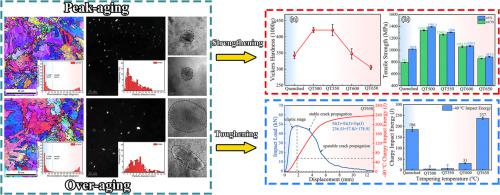International Journal of Plasticity ( IF 9.4 ) Pub Date : 2023-06-01 , DOI: 10.1016/j.ijplas.2023.103654 Xiaocong Yang , Xinjie Di , Jingsong Wang , Chao Fang , Wen Fu , Lingzhi Ba , Xiaofeng Zhou , Chuanyou Zhang , Chengning Li

|
The designed low-carbon ultra-high strength martensite seamless tube steel was manufactured by hot rolling and quenching-tempering processes. The multiple strengthening mechanisms are evaluated depending on the microstructure and co-precipitation evolution mechanism of Cu and NiAl, and the toughening mechanisms associated with multiscale microstructures are systematically discussed. The results show that the microstructure of the experimental steel in the quenched state consists of 87.8% lath martensite (LM) and 12.2% granular bainite (GB), while the microstructure in the QT state includes tempered martensite (TM), GB and a small amount of reversed austenite. The TEM morphology of QT steel shows three types of nanoparticles co-precipitated by Cu-rich, NiAl and Cu-NiAl, and the nanoparticles coarsen significantly and the number density decreases dramatically as the aging temperature increases from 500 °C to 650 °C. The co-precipitation evolution mechanism of nanoparticles elucidates that high density of small-sized BCC Cu and B2-NiAl particles is optimal for strengthening increment. The experimental steel has an maximum yield strength of 1332.5 MPa aged at 500 °C, which is attributed to high precipitation strengthening of 651.2 MPa (general superposition of shear strengthening and Orowan strengthening) and dislocation strengthening of 454.8 MPa. The experimental steel has obvious low-temperature toughening, and the impact energy at -40 °C increases from 5 J to 237 J as the aging temperature increases from 500 °C to 650 °C. The excellent low-temperature toughness is attributed to the reduction of dislocation density, the weakening of the shear mechanism and the transformation of a small amount of reversed austenite to increase the crack nucleation energy, and the increase of the number fraction of HAGB and the significant plastic deformation increase the crack propagation energy.
Cu and B2-NiAl particles is optimal for strengthening increment. The experimental steel has an maximum yield strength of 1332.5 MPa aged at 500 °C, which is attributed to high precipitation strengthening of 651.2 MPa (general superposition of shear strengthening and Orowan strengthening) and dislocation strengthening of 454.8 MPa. The experimental steel has obvious low-temperature toughening, and the impact energy at -40 °C increases from 5 J to 237 J as the aging temperature increases from 500 °C to 650 °C. The excellent low-temperature toughness is attributed to the reduction of dislocation density, the weakening of the shear mechanism and the transformation of a small amount of reversed austenite to increase the crack nucleation energy, and the increase of the number fraction of HAGB and the significant plastic deformation increase the crack propagation energy.
中文翻译:

NiAl和Cu纳米粒子的共沉淀演化及其对低碳超高强马氏体无缝管钢强韧化机制的影响
设计的低碳超高强度马氏体无缝管钢采用热轧和调质工艺制造。根据 Cu 和 NiAl 的微观结构和共沉淀演化机制评估了多种强化机制,并系统地讨论了与多尺度微观结构相关的增韧机制。结果表明,实验钢在淬火状态下的显微组织由 87.8% 的板条马氏体(LM)和 12.2% 的粒状贝氏体(GB)组成,而在 QT 状态下的显微组织包括回火马氏体(TM)、GB 和少量反转奥氏体量。QT钢的TEM形貌显示出三种由富Cu、NiAl和Cu-NiAl共沉淀的纳米粒子,随着老化温度从 500 °C 升高到 650 °C,纳米粒子明显粗化,数密度急剧下降。纳米颗粒的共沉淀演化机制阐明了高密度的小尺寸 BCC Cu和B2-NiAl颗粒是强化增量的最佳选择。实验钢在 500 °C 时效时的最大屈服强度为 1332.5 MPa,这归因于 651.2 MPa 的高析出强化(剪切强化和 Orowan 强化的一般叠加)和 454.8 MPa 的位错强化。实验钢具有明显的低温增韧作用,随着时效温度从500℃上升到650℃,-40℃冲击功从5J上升到237J。优异的低温韧性归因于位错密度的降低、剪切机制的减弱以及少量反转奥氏体相变增加裂纹形核能,
Cu和B2-NiAl颗粒是强化增量的最佳选择。实验钢在 500 °C 时效时的最大屈服强度为 1332.5 MPa,这归因于 651.2 MPa 的高析出强化(剪切强化和 Orowan 强化的一般叠加)和 454.8 MPa 的位错强化。实验钢具有明显的低温增韧作用,随着时效温度从500℃上升到650℃,-40℃冲击功从5J上升到237J。优异的低温韧性归因于位错密度的降低、剪切机制的减弱以及少量反转奥氏体相变增加裂纹形核能,











































 京公网安备 11010802027423号
京公网安备 11010802027423号